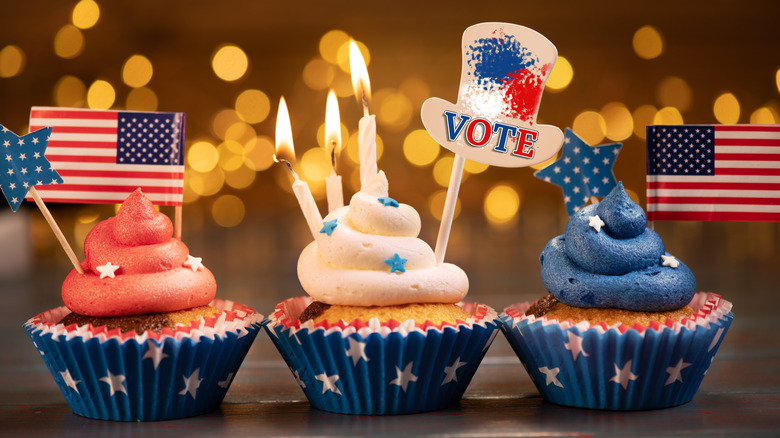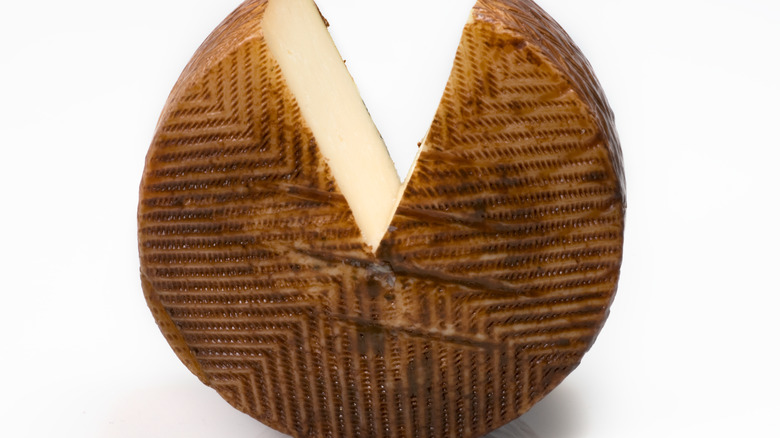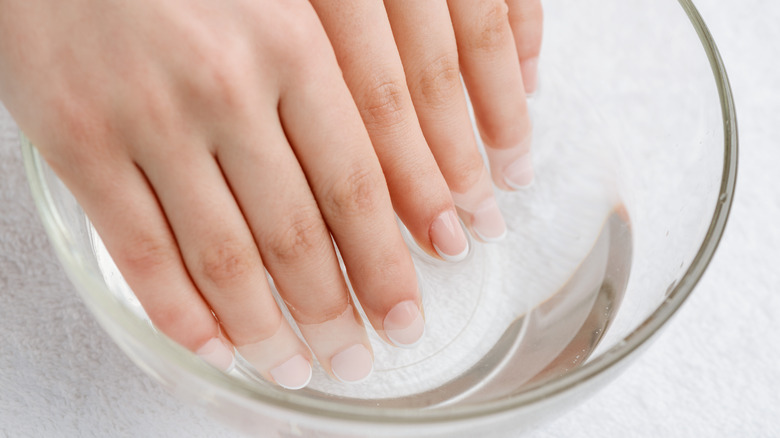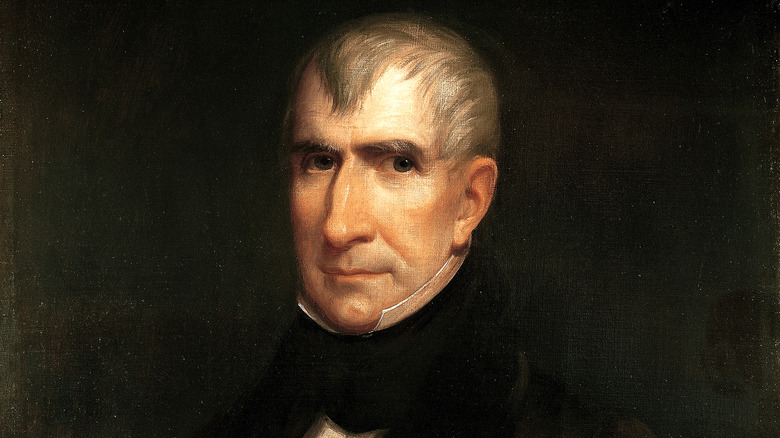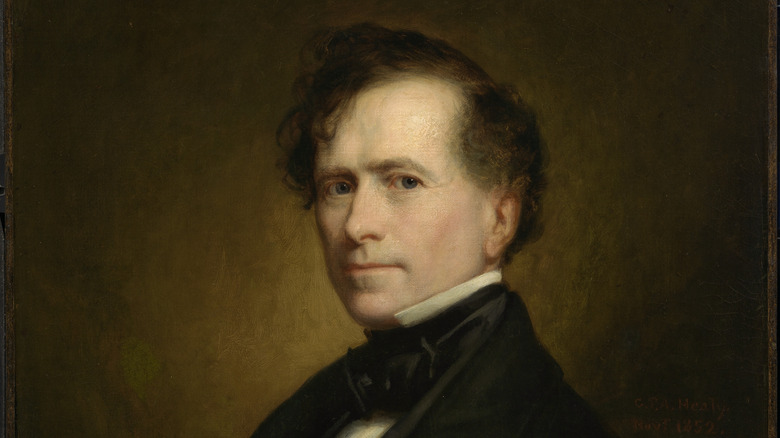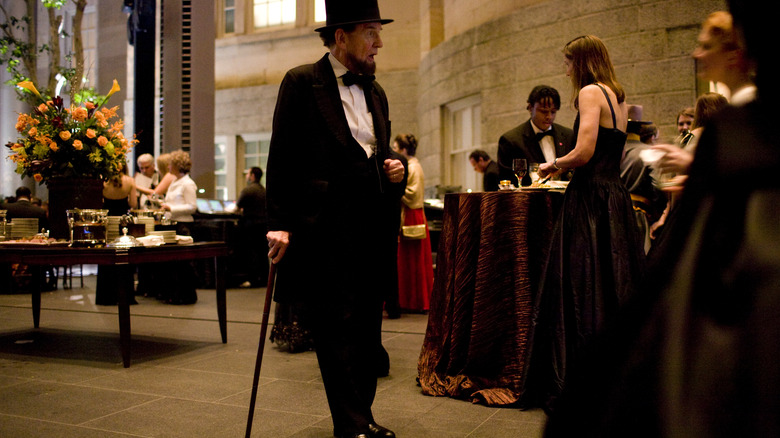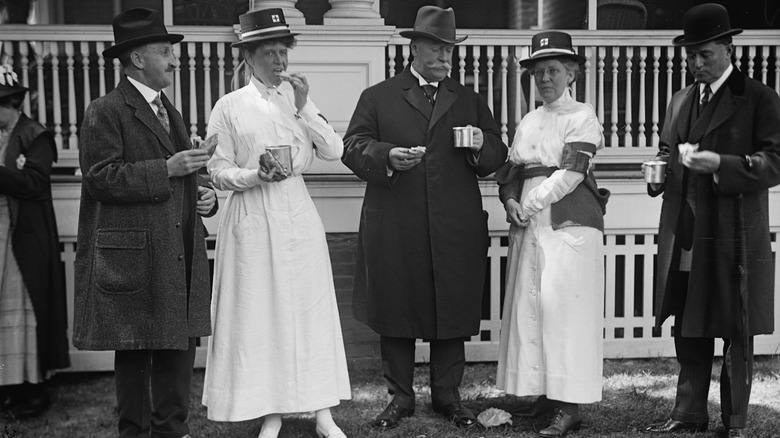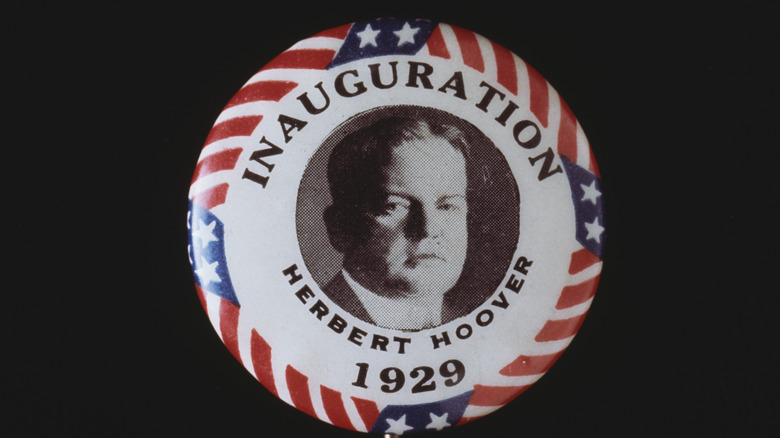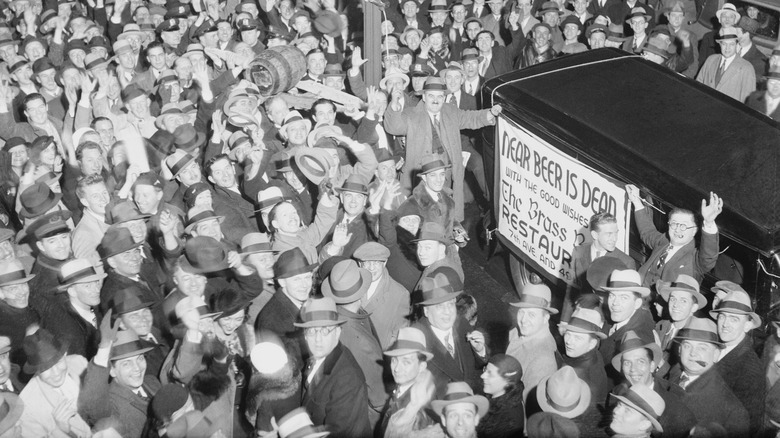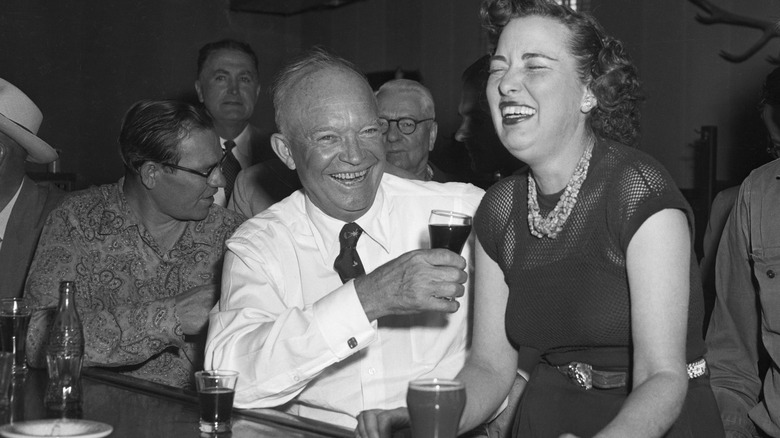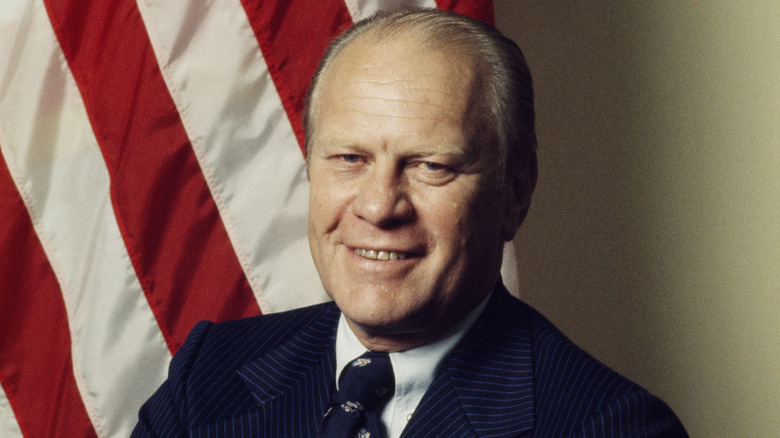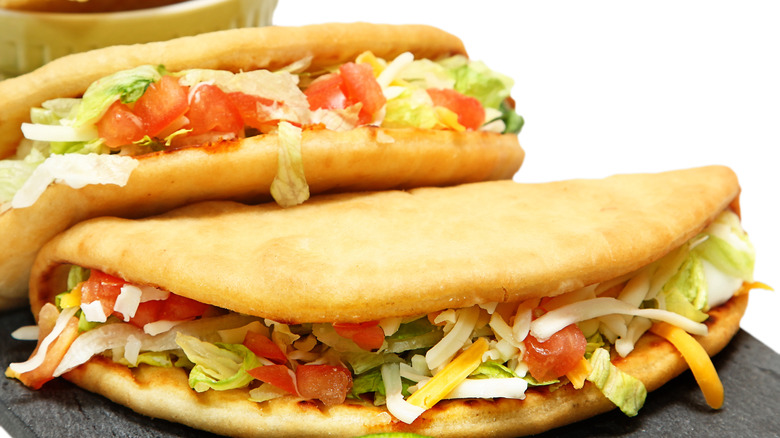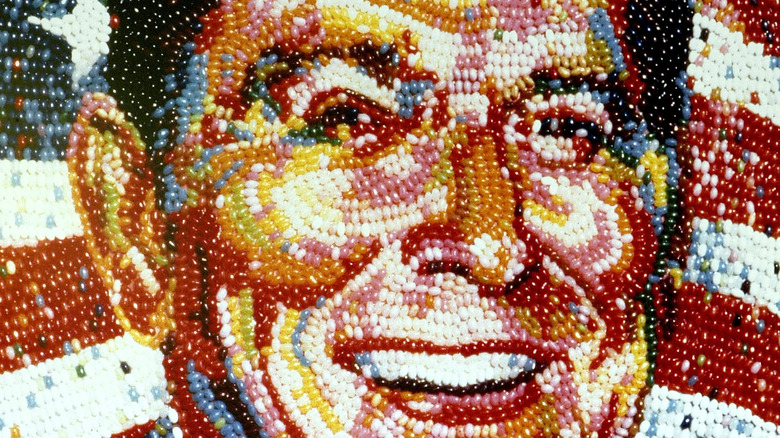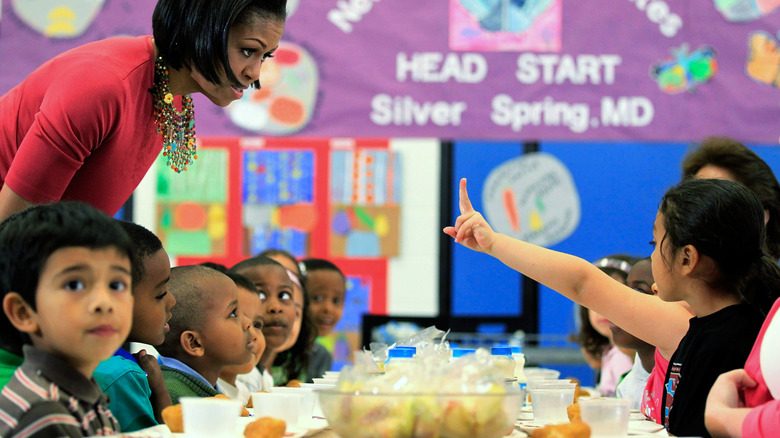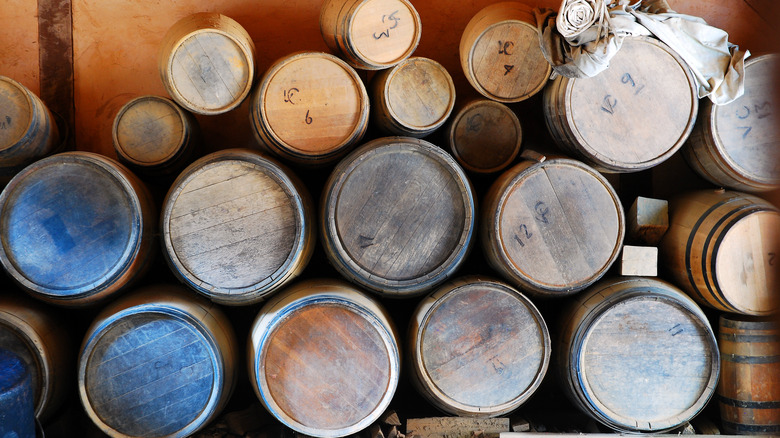14 Presidents Whose Elections Were Defined By Food
In 1992, when vice presidential hopeful Dan Quayle misspelled "potato" at a sixth-grade spelling bee, the nation gave him a good-natured ribbing. But personal embarrassment aside, Quayle might have sensed that his grammar school slip of the tongue could mushroom into a serious campaign bugaboo.
Politicians have long known that the best way to get to a voter's heart is through his stomach. Sure, voters could play drinking games when watching debates, or trade trivia about the favorite foods of any Commander-in-Chief (tip: President Biden has a soft spot for angel hair pasta). But when it comes to stumping on the trail, nothing catches the attention — and appetites — of voters more than a hearty meal.
As a historian, I've come across plenty of election tactics used by presidential hopefuls. Although plying voters with free grub is technically illegal, candidates have long used food strategies to grab the spotlight and reward supporters. Here are 12 food strategies that winning presidential candidates used on the campaign trail — and a few that backfired.
Andrew Jackson's cheese wheel
Andrew Jackson wasn't one of the Founding Fathers, but Old Hickory — as he was called for his durable war record– considered himself more of a man of the people. One dairy farmer in New York, Thomas Meacham, sent the president a 1,400-pound cheese wheel in late 1835 as a symbol of industrial pride and prosperity in New York. The 4-foot wide, 2-foot thick cheese wheel required the milk from 150 cows over 4 days and was shipped by schooner to Washington. An appreciative Jackson accepted the gift from "our hardy yeomanry in the State of New York" (via ThoughtCo).
Jackson kept the cheese, but he had no idea what to do with it. The wheel sat at the White House entry for two years. By 1837, with his term ending, Jackson made good on his reputation as the embodiment of the people by inviting the public for a free-for-all snack, first come, first served. A stampede of 10,000 people consumed the cheese in 2 hours, trampling crumbs into the carpets and leaving a strong odor that lingered around the White House and surrounding blocks for days.
Martin Van Buren's finger bowls
After Andrew Jackson wrapped up his term, his successor, Martin Van Buren, fully intended to whitewash the White House by not just clearing out the stink of cheese and commoners, but to improve the president's diet. Out went the cheese wheels and in came gold tableware and chandeliers to present a more dignified look for the Oval Office and the dining room.
But Van Buren didn't count on critics, many of whom sneered that he was wasting taxpayer money on imported finger bowels more suitable for Buckingham Palace than the White House to line the banquet halls. In their eyes, the president had replaced good old-fashioned fried meats and gravies with champagnes, bonbons, and other French cuisine.
Now, knowing when to use finger bowls is a sign of etiquette for the dining table, but, as reported by The History Chef, Van Buren's opponents in the Whig Party, especially Representative Charles Ogle from Pennsylvania, railed against the president's frivolous utensils to wash his "soft, white, lily fingers, after dining on Fricandeau de Veau and Omelette Soufflé," considered this luxury a sign of weakness and potentially even considered unpatriotic. Van Buren lost the 1840 election to his opponent, William Henry Harrison.
William Henry Harrison's squirrel stew
William Henry Harrison's landslide win in the 1840 election seemed like another victory for the common man. Harrison was born into wealth, unlike the rags-to-riches Van Buren, but his campaign smartly showcased Harrison as an American foodie. Flyers frequently presented the candidate surrounded by corn, wheat, cider, and other common staples, unlike Van Buren. Harrison quickly capitalized on his victory by throwing a feast that included his favorite stew: burgoo. This home-grown Kentucky meal was another reminder of the hearty frontiersman who lived off the land and by his wits. For Harrison's feast, the main ingredient was a fellow forager abundant in the American hinterland: squirrels.
Harrison's squirrel stew was a hit among voters. While the modern palate might shy away from these acorn-storing critters, cash-strapped rural Americans knew that squirrels were a great source of protein and energy (the USDA would confirm a century later that cholesterol from squirrel meat was a bit on the high side). In fact, the Massachusetts state government's homepage still has instructions for hunters on how to clean and prep squirrel meat for a squirrel pot pie fresh from the hunt. Alas, Harrison died a month into office, earning him a place in trivia games for the shortest presidency rather than his food savvy.
Franklin Pierce's love of drink
Political rivals have played dirty ever since George Washington left office. Franklin Pierce is an early example of a presidential candidate who was maligned in the press for his eating habits. The 14th president isn't a known name these days, but back then, it was no secret how much Pierce loved his liquor.
In the 1852 presidential campaign, cartoonists took quill to paper to depict Pierce, bottle in hand, toasting Maine's temperance laws in a mock celebration. Another political cartoon showed Commander-in-Chief Pierce leading the army to battle before straggling behind, clenching his gut in pain, a malady that foreshadowed the cirrhosis of the liver that claimed his life in 1869.
Pierce won the White House, but his administration struggled to deal with slavery and the looming Civil War. Reporters commented cryptically on how Pierce's political troubles took a toll on his health, no doubt making a veiled reference to his drinking. Pierce ended his term in serious physical decline, with his face appearing to reporters as "so ghastly and cadaverous that one could almost fancy he was gazing on a corpse," per Politico. Pierce himself didn't mince words. When asked about his future plans, the ex-president commented, "There's nothing left but [to] get drunk."
Abraham Lincoln's inaugural food fight
Abraham Lincoln's life has inspired everything from bank names to Log Cabin maple syrup. When it came to food, Honest Abe loved simple fare, from a basic burnt sugar cake made by his wife, Mary Todd, to hearty bacon.
In 1865, having won in a landslide and with the Civil War's end within sight, Lincoln threw an inaugural gala. But while Lincoln was a grand tactician in the game of politics, he miscalculated when it came to partying. The menu was spectacular, with French pâté and tarts mingled with meats from pheasant to venison, fruits, and six flavors of ice cream. Per Smithsonian Magazine, over 4,000 guests attended, having paid $10 per ticket just for a glimpse of the First Couple.
At the stroke of midnight, dinner was finally served. The dancing, mingling, and chitchat left the guests famished, and the sight of the feast on a 250-foot-long table spurred a charge among the Washingtonians. Diners jostled as they piled their plates and carried the food back to their tables, spilling it over clothes, décor, and each other. By the time it was over, the Washington Evening Star, as per NPR, reported, "The floor of the supper room was soon sticky, pasty and oily with wasted confections, mashed cake and debris of foul and meat." The dinner clearly didn't go according to plan, but Lincoln loved a good wrestling match. He might have seen the mealtime melee with a glint of humor.
William Howard Taft's possum branding
William Howard Taft, like Presidents Theodore Roosevelt and Benjamin Harrison before him, enjoyed possum dinners, and not just for the protein and fat. As the Library of Congress notes, possums were a favorite among white Southerners and Black Americans alike, and Northern-born presidents hoped to score public relations points with both groups that were normally at loggerheads.
After his victory in the 1908 election, Taft dined with the Atlanta Chamber of Commerce. "I have had a lifetime longing to taste 'possum and 'taters.' My visit to the south would be incomplete unless this wish is realized," the president-elect said, as per the Library of Congress. At the feast, Taft and hundreds of civic boosters enjoyed roast quail casserole and persimmon beer. The Chamber of Commerce rewarded Taft's gusto with Billy Possum, a stuffed toy possum that supporters hoped to sell as the successor to Theodore Roosevelt's teddy bear. A marketing bonanza shortly followed, with sheet music, fine china, cartoons, and games that showed Billy Possum shoving Teddy Bear out of the national spotlight.
It didn't work. Roosevelt had spared the bear that became a beloved children's toy, but Taft didn't help sell Billy's image when he and the rest of the nation cooked and devoured the possums that their kids cuddled. Billy Possum quickly vanished into the dustbins of antique shops, while its culinary counterpart fell into obscurity on the American dinner plate.
Herbert Hoover's chicken dinner
When running for president in 1928, Herbert Hoover promised that the good times would keep on rolling. The United States was on a runaway train of prosperity during the 1920s, all under Republican administrations. As noted by the State Historical Society of Iowa, ad copy for Hoover's campaign, which was published by a local committee, exclaimed, "The Republican Party isn't a Poor Man's Party!" and promised "a chicken for every pot" if Hoover was elected.
An abundance of poultry wasn't just a campaign slogan. Chicken played a vital role in American culinary cuisine, from fried chicken in Southern towns like Gordonsville, Virginia, to Sunday dinners bursting with chicken pot pies, casseroles, and family togetherness. By promising a never-ending supply of chickens, Hoover's supporters pointed to their candidate as the right man to ring in prosperity for all.
Unfortunately, 10 months into Hoover's term, the stock market crashed and the Great Depression pretty much tanked Hoover's presidency. Democrats began using the "chicken in every pot" line as a reminder of a failed campaign promise. While Hoover never actually uttered those exact words, voters remembered that, under Hoover, every pot threatened to run empty.
Franklin Roosevelt made liquor legal again
In 1932, Franklin D. Roosevelt proposed a New Deal for the American people, but food wasn't exactly a part of the program. The Roosevelt Administration had a reputation for having the worst food of any presidency, which surprisingly made for good politics. With the Great Depression raging, it wasn't good PR for the patrician-born Roosevelt to host luxurious dinners while everyday Americans went hungry. Instead, he and his wife Eleanor took pride in offering humble fare straight from the figurative discount rack.
But Roosevelt did score political points in one big way. He campaigned to end Prohibition and to bring liquor out of the bathtubs and onto store shelves again. In one of his first memos to Congress after election — his "shortest on record," notes the FDR Library, – the president recommended legalizing the manufacturing and sale of beer. FDR might not have minded an occasional drink, but his goal was more economic than culinary. The projected tax income that would be collected from alcohol sales would generate needed revenue to fund government programs while deflating the coffers of bootleggers and gangsters. For foodies, this meant that the honey-gin and pink lady cocktails that were secretly mixed in backrooms could not only be downed in public but were official contributions to the American palate.
Dwight David Eisenhower's Coca-Cola ad
When Dwight David Eisenhower was elected in 1952, the 62-year-old general was one of America's oldest presidents. But Eisenhower was far from being behind the times. With his finger on the pulse of the new baby boom generation, Eisenhower embraced modern innovation. The Eisenhower National Historic Site even claimed that occasionally, the Eisenhowers spent evenings watching their new television set while enjoying TV dinners perched on TV trays. What was on the air? Most likely, "I like Ike" campaign ads
Eisenhower was already liked by millions of G.I. vets. A decade earlier, during World War II, General Eisenhower recognized that soldiers in the European Theater kept their fighting spirits up by having reminders of home. As noted by the American G.I. Museum, in 1943, Eisenhower sent a telegram to Coca-Cola, asking the company for 10 portable bottling plants that could churn out six million bottles of Coke per month for the Americans overseas. Coke eagerly agreed. Flash forward to 1952 when Eisenhower was up for election. Ike kicked off his campaign by reminding vets and their kids that this warhorse wasn't ready to be put out the pasture just yet. Posing for the cameras, Eisenhower took a swig from a chilled bottle of Coca-Cola. Classic.
Gerald Ford's terrible tamale
When it comes to making tamales, one of the most crucial tips to remember is that the corn husk is a key ingredient, but it's best to leave them in the compost bin when the meal is over. Corn husks may be high in fiber and nutrients, but they aren't exactly bursting with flavor that goes well with the rest of the tamale.
Unfortunately, novices eating tamales might not realize that corn husks are for peeling, not eating. President Gerald Ford made that unfortunate mistake on the campaign trail in 1976. When visiting the Alamo on a campaign stop to win over Texans, Ford stopped by a plate of tamales, picked one up, and promptly bit off a chunk without bothering to remove the outer husk wrapping. As recounted by Chron, Ford's guide, San Antonio Mayor Lila Cockrell, recalled hearing the gulps from Ford's entourage as the president committed his culinary faux pas.
While Cockrell laughed off Ford's blunder as a human mistake, the whirring cameras said otherwise. Per Vice, one news correspondent claimed that Ford almost choked, and other political pundits wondered if the Great Tamale Incident cost Ford his second term.
Jimmy Carter's honorary peanut taco
While Gerald Ford suffered through his tamale, his Democratic opponent that year, Jimmy Carter, was doing much better on the food front. While also campaigning in Texas, members of the San Antonio-based National Taco Council gifted Carter a colossal chalupa stuffed with 10 pounds of refried beans, 10 lettuce heads, and 5 pounds of Georgia peanuts, the latter honoring the former peanut farmer (via Texas Monthly). The chalupa was an apt choice — this Mexican-American culinary hybrid has tied the two nations together, as evidenced by the crowd that devoured it before Carter had a chance to enjoy the moment. Enough votes went to Carter to win him both Texas and the presidency.
After his victory, Carter was honored with a peanut taco by Osvaldo Rodriguez, a local San Antonio restaurateur. Rodriguez's Enchilada Hut featured the Jimmy Carter Taco, which consisted of crushed dried peanuts mixed in with scrambled eggs and wrapped in a flour tortilla. While Rodriguez thought the egg and peanut combo gave it pork flavor if eaten without coffee, other customers found it too sweet with a peanut butter consistency. In any case, Carter maintained true to his Southern diet, including requesting that his White House chefs serve county-style meals.
Ronald Reagan's humble jelly beans
When President Ronald Reagan shipped 3.5 tons of jelly beans to his 1981 inauguration, it wasn't just a political stunt. According to the Ronald Reagan Library, the 40th president had grown fond of the fruity candy confections, which had helped wean him off pipe smoking back in 1966. By 1980, jelly beans, especially Herman Goelitz's Jelly Belly brand, had a permanent home on his desk.
But jelly beans were more than just a quick sugar rush. Reagan liked to joke that he could tell much about a person by the way they ate jelly beans. Reagan's nickname was the Great Communicator for his folksy, home-spun demeanor, and jelly beans became part of his persona. Throughout his political career, Reagan handed out jelly beans to dignitaries and guests as a symbol of the simple joys of life that stretched around the globe.
It's no wonder, then, that for his inauguration bash, Reagan went all out with jelly bean Americana. The flavors chosen for the bash were Very Cherry red, coconut white, and blueberry blue (a new flavor Jelly Belly created just for the occasion).
Barack Obama's school lunch makeover
Ah, school lunches. While countries around the world treat their kids to gourmet grub, children in the U.S.A. have stereotypes of hair-netted matrons dishing out soup and milk in assembly-line fashion. School lunches in the U.S.A. have come a long way: It took 40 years for school lunch programs to grow from eclectic volunteer programs in 1912 to set federal standards. Despite changes in food choices and nutritional needs, the program has endured for decades.
By the time Barack Obama took office in 2008, many American kids were in trouble. As noted by the CDC, rising childhood obesity rates and easy access to junk food were made worse by fast foods becoming school lunch staples. First Lady Michelle Obama spearheaded the Let's Move! initiative to "change the way a generation of kids thinks about food and nutrition." Better school lunches became a campaign promise in the 2012 election, with President Obama declaring National School Lunch Week to celebrate fruits, veggies, and other wholesome snacks.
Despite Obama going on to win the election, not everyone was thrilled. The Washington Post reported that numerous kids tweeted Michelle Obama with pictures of lunches made of mashed meat blobs and sickly, leafy greens where pizza and burgers used to be. Yet, the former first lady remains committed to solving the children's nutritional health crisis and promoting healthy food options through DIY vegetable gardens. As for kids, well, complaining about school lunches is as old as school lunches themselves.
James Madison's refusal to fight with food
Not every politician counts calories as well as voters. Per the National Archives, in 1777, James Madison took a principled stand against courting the public with food and drink. Running for a seat in the Virginia Legislature during the Revolutionary War, Madison could have enticed voters by offering up rum and vittles. Had he done so, he would have been in good company. Back in 1758, George Washington, having been shut out from an election to the House of Burgesses three years earlier, poured on the libations to prospective voters, and the public swallowed it (via U.S. News).
But Madison was resolute in his beliefs in civic virtue. He rejected using "spirituous liquors and other treats," taking a principled stand to run elections without booze. He lost. A month later, charges were brought up against candidate Charles Porter for bribing his constituents, presumably with excess alcohol. The charges were dropped weeks later.
While Madison separated snacks and states, his wife Dolley left a mark on American cuisine, including the snack brand named after her. In addition to her duties as hostess, the first lady's sweet tooth leaned toward the extravagant, as her fondness for oyster ice cream might suggest.
